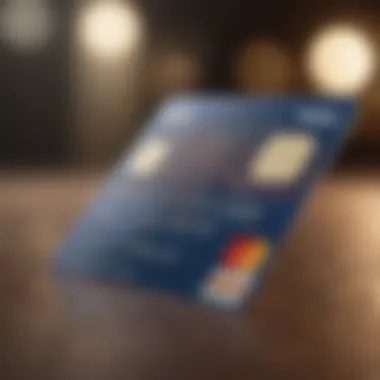Withdrawing Cash from a Prepaid Visa Card Guide


Intro
With the rise of digital payments and cashless transactions, prepaid Visa cards have gained substantial popularity. They offer an easy method to manage spending while ensuring you don't exceed your budget. However, as convenient as these cards may appear, there are underlying rules and processes regarding withdrawing cash that every user should be aware of.
This guide serves as a roadmap, helping both novices and seasoned users navigate the sometimes murky waters of cash withdrawals from prepaid Visa cards. By breaking down essential terminology, processes, potential fees, withdrawal limits, and offering practical tips, our goal is to make your card experience smoother and more efficient.
So, whether you're preparing for a weekend getaway or simply need a strategy for handling your finances better, understanding how to withdraw cash from your prepaid Visa card can empower you significantly. Let's dig into the details to equip you with all you need.
Understanding Prepaid Visa Cards
In today’s financial landscape, prepaid Visa cards have carved out a niche of their own, providing unique advantages. Unlike traditional debit or credit cards, these cards function on a distinct principle that combines convenience and control. Understanding the essence of prepaid Visa cards sets the stage for effectively managing withdrawals, expenses, and budgeting.
Definition and Functionality
A prepaid Visa card is a financial tool that allows users to load a specific amount of money onto the card before they can use it. It works much like a debit card; however, the most significant difference is that you can only spend what’s already been loaded onto it. This pre-payment nature helps users maintain better control over their finances, making it a fitting option for those who find budgeting challenging. The card can be used for online purchases, in-store transactions, or cash withdrawals, offering a blend of flexibility and security.
Key Features
The primary appeal of prepaid Visa cards derives from their various features, which include:
- No Bank Account Needed: Unlike many credit or debit card options, no need to have a bank account. This accessibility can be a game changer for individuals facing banking limitations.
- Limitations on Spending: Since users can only spend the amount loaded, it shields them from debt overspending. This usually encourages healthy financial habits.
- Ease of Use: Much akin to cash, prepaid cards are simple to use. Users can load them and start spending right away. Also, they are widely accepted at millions of locations.
- Reloadable Options: Many prepaid Visa cards offer the ability to add more funds, bringing convenience without having to get a new card each time.
Types of Prepaid Visa Cards
There are various types of prepaid Visa cards, tailored to meet different needs and preferences. Here are some common categories:
- General Purpose Reloadable Cards: These are versatile cards that can be reloaded and are used for everyday spending.
- Gift Cards: Often given as gifts, these cards come preloaded with fixed amounts and are not reloadable, meant for discretionary spending.
- Travel Cards: Designed for frequent travelers, these cards can help in minimizing foreign transaction fees and provide enhanced security for funds abroad.
- Payroll and Government Benefit Cards: These cards are loaded with salaries or benefits, allowing recipients to easily access their funds without needing a bank account.
Each card serves its purpose uniquely, but their core functionality remains accessible and beneficial for users looking to manage their finances wisely.
The Process of Withdrawing Cash
Withdrawing cash from a prepaid Visa can sometimes feel like navigating a maze, especially for those new to it. Understanding this process is crucial, as it helps users manage their finances effectively while making the most of their prepaid cards. Many individuals rely on these cards for better control over spending, so knowing the ins and outs of cash withdrawals is paramount.
Key Elements to Consider
Various methods are available for withdrawing cash from a prepaid Visa card. Each method comes with its own set of benefits, limitations, and fees. By familiarizing oneself with these methods, users can make informed decisions that suit their financial situations.
Moreover, grasping the subtle differences between withdrawal methods can save a user a few bucks in fees, not to mention time. Cash access is often integral, especially when one is on the go or faces unexpected expenses; knowing all your options is half the battle.
Identifying Withdrawal Methods
When it comes to cash withdrawal, users have a range of options to choose from. Understanding these withdrawal methods is key to optimizing your card usage.
- ATMs
- Retail Locations with Cash Advances
- Bank Counter Withdrawals
Each of these methods has its own particular nuances. ATMs can be found everywhere, from malls to gas stations. Retail locations often offer cash advances, especially during checkout—useful is a pinch.
Using ATMs for Withdrawal
Using an ATM to withdraw cash from a prepaid Visa card tends to be the most straightforward approach. Most cardholders will find it quite familiar, akin to how one operates a debit card. Here’s how it usually works:


- Look for an ATM that accepts Visa cards.
- Insert your prepaid Visa into the machine.
- Enter your PIN, and select the option for cash withdrawal.
- Choose the amount you’d like to withdraw, keeping your card limits in mind.
- Retrieve your cash and ensure you take your card.
While this option is relatively simple, users should note any fees charged by either the ATM operator or the card issuer. It’s worth checking the terms to avoid any surprises. Remember, not all ATMs are created equal; some might offer better terms than others. Always be satiable—check for the best options.
Cash Advance at Retail Locations
Cash advances at retail locations represent another useful method for accessing cash. Many stores provide this service at the checkout counter. While it's especially handy during shopping trips, there are a few points to keep in mind.
- Check Eligibility: Not every retailer allows cash advances, so it’s advisable to ask beforehand.
- Fees May Apply: Similar to ATMs, retailers may impose additional fees for this service. A little due diligence goes a long way, ensuring you’re not caught off guard.
- Purchase Requirement: In most cases, you may need to make a minimum purchase to avail of a cash advance. This can seem counterintuitive; however, it’s just part of the deal.
In sum, understanding these two withdrawal methods—ATMs and retail cash advances—can significantly enhance how users interact with their prepaid Visa cards. As this guide unfolds, each methodology explores more options to cater to individual needs.
Associated Fees and Limits
When it comes to using a prepaid Visa card, understanding the associated fees and limits is paramount. These factors play a critical role in managing your finances effectively. They can vary significantly depending on the card issuer and the specific type of card you choose. Knowing these fees and limits helps you avoid unpleasant surprises that can lead to mismanagement of funds and increased costs.
Transaction Fees
Transaction fees are the charges that may be applied each time you use your prepaid Visa card. These fees can include withdrawal charges at ATMs and point-of-sale transaction fees. Let’s break it down:
- ATM Withdrawal Fees: Withdrawals from ATMs often carry a fee, typically around $2 to $3 per transaction. This rate can increase if you use an ATM outside of your card’s network.
- Purchase Fees: Each time you make a purchase, you may encounter a small fee, especially at certain retailers or if you’re loading funds onto your card. It’s essential to read the fine print on your card agreement to understand these charges fully.
Being aware of transaction fees enables you to strategize when and where to use your card, ensuring that you’re not draining your funds with unnecessary costs.
Daily Withdrawal Limits
Daily withdrawal limits refer to the maximum amount of cash you can withdraw from your prepaid Visa card in a single day. These limits are set by the card issuer and can vary widely. Some typical withdrawal limits range from $300 to $1,000 per day, though it can be lower for certain cards.
Understanding these limits is important because:
- Planning Your Withdrawals: If you know your daily limit, you can plan ahead. This might prevent a situation where you attempt to withdraw more cash than allowed and get denied.
- Cash Flow Management: Knowing how much you can withdraw gives you better control over cash flow, which can be crucial if you typically rely on your prepaid card for daily expenses.
Inactivity Fees
Inactivity fees are charged if your prepaid Visa card hasn't seen any transactions for a specified period, typically ranging from six to twelve months. This charge is often intended to encourage users to keep their accounts active. Here’s why it matters:
- Avoiding Unwanted Charges: If you have a prepaid card that you don’t use frequently, keeping an eye on inactivity fees can save you from losing a portion of your funds unexpectedly.
- Financial Awareness: Regularly using or loading your card helps you stay within your budget and feel more in control of your finances.
Frequent checks on your card balance and activity could save you from unnecessary fees and help maintain full access to your funds.
Maximizing the Use of Prepaid Visa Cards
Prepaid Visa cards provide a unique blend of convenience and control. Understanding how to maximize their potential is crucial for users who want to make the most of their financial resources. Effective management of a prepaid card can give you benefits that extend beyond just simple transactions. It's about using it wisely to save money, avoid unnecessary fees, and maintain a clear snapshot of your financial standing.
Understanding Card Limits and Benefits
Knowing your card limits is half the battle. Prepaid cards often come with a maximum load limit, meaning you can only load a specific amount of money on it. This limit varies widely between different cards. Some might offer a cap of just $500, while others allow loads of several thousand dollars. By understanding these limits, you’re not just keeping your finances in check, but also preventing embarrassing situations like declined transactions.
For instance, a typical strategy is to only load the amount of money you plan to spend within a certain time frame, like a month. This can protect you from overspending. Paying particular attention to any restrictions helps you make well-informed choices.
Here are some benefits tied closely to understanding these limits:
- Budget Control: You can easily manage your spending by keeping a close eye on your balance and limits, assisting with making budgets.
- Transparency: Many prepaid cards provide an online portal where you can track your transactions in real time, enhancing visibility into your spending habits.
- No Overdraft Fees: As prepaid cards are not linked to a bank account, there’s no chance of overdrafting, which can haunt you with fees.


Strategies for Efficient Use
Making your prepaid Visa card work for you calls for a bit of planning and strategy. Here are some effective tips to enhance its utility:
- Autoload Feature: Some prepaid cards allow for automatic loading. By linking them to a checking or savings account, a fixed sum can be automatically transferred. This ensures that your card always has enough funds for regular expenses, like groceries or gas.
- Utilize Fee-Free ATMs: Not every ATM offers free cash withdrawal on prepaid cards. It pays to do a little research и find ATMs that don’t charge fees. Websites or apps often provide databases of these locations.
- Use for Specific Purchases: Designate your prepaid card for specific spending categories like dining out or split bills with friends. This way, it encourages responsible spending while maintaining a financial buffer.
- Keep Track of Your Balance: Frequently checking your balance can prevent accidental overspending and alert you to unauthorized purchases early on. A simple calculation at the start of the week could keep your finances in line.
"Prepaid cards can be a powerful financial tool when used with intent and knowledge."
By carefully considering these strategies, you'll enhance your ability to manage your prepaid Visa card efficiently. Using these cards effectively can lead to smarter spending habits and even potential savings in the long run. By embracing good practices, you're not only maximizing the value of your card but also taking strides toward more informed financial management.
Comparing Prepaid Visa Cards to Other Financial Products
Understanding the differences between prepaid Visa cards and other financial products is crucial. This comparison sheds light on the benefits, limitations, and various contexts in which these cards shine or struggle. Knowing how prepaid cards stack up against debit and credit cards can inform potential users about the most suitable option for their financial needs.
Prepaid Cards vs. Debit Cards
Prepaid cards and debit cards share some similarities, but their functions and uses diverge significantly.
1. Access to funds:
A prepaid Visa card requires the user to load it with money before use. Essentially, it's like a gift card that can be used anywhere that accepts Visa. In contrast, a debit card is linked directly to a checking account, drawing from the available balance whenever a transaction occurs.
2. Spending control:
Prepaid cards can help manage spending. Once the funds are exhausted, no further transactions can be processed, which can be ideal for budgeting. Debit cards permit overdrafts in some cases, leading to potential fees—an unnecessary surprise.
3. Qualification requirements:
Prepaid cards offer access without credit checks or the need for a bank account, making them more accessible for various individuals, particularly those who may face challenges obtaining other forms of payment. Debit cards generally require a bank account and can present hurdles for those with poor credit histories.
4. Fees:
Peeling back the layers of prepaid cards reveals a spectrum of fees, including activation and maintenance charges. Conversely, debit cards often incur lower or no fees, relying instead on bank policies. However, certain debit accounts charge monthly fees unless certain conditions, like minimum balances, are satisfied.
Prepaid cards serve as a budget-friendly tool, providing an alternative for those wary of overspending with debit cards. Understanding these differences can lead users to make informed choices about their spending habits.
Prepaid Cards vs. Credit Cards
The comparison between prepaid cards and credit cards heads into another realm of assessing financial responsibility and leveraging credit properly.
1. Getting credit:
Credit cards allow customers to borrow against a credit limit. This borrowing can assist emergency needs, building credit history, or earning rewards. Prepaid cards, however, do not impact one’s credit score as you do not borrow, only spend money you previously loaded onto the card.
2. Interest and fees:
With credit cards, it’s crucial to fathom the impact of high-interest rates. Accumulating debt can lead to steep financial burdens. Prepaid Visa cards, in contrast, encourage cautious financial practices, only permitting spendings within previously set limits, thus eliminating the risk of accruing debt.
3. Rewards and benefits:
Many credit cards offer perks like cashback, travel rewards, or points on purchases, incentivizing users for their spending. Prepaid cards generally lack these rewards, as their primary function serves as a limited payment method rather than an avenue to earn points or perks.
4. Usage Flexibility:
Credit cards are often seen as more versatile for making purchases online or over the phone, especially for services requiring holds on funds, like hotels. Prepaid cards might encounter challenges in these situations if the available balance does not meet the hold requirement, which can lead to declined transactions.
Ultimately, the decision hinges on the user's financial practices and goals. Prepaid cards can offer a safety net, particularly for those looking to leverage financial independence without entangling credit.
In summary, comparing prepaid Visa cards to debit and credit cards showcases distinct features that cater to different needs. Familiarity with these elements empowers users to choose wisely.
Common Mistakes to Avoid
When engaging with financial products such as prepaid Visa cards, understanding common pitfalls is crucial. Mistakes can lead to unnecessary expenses or frustration, so being aware of the frequent errors can save you time and money. This section highlights two major missteps that users often experience with their prepaid Visa cards, and it provides guidance to help navigate these issues.
Overlooking Fees
One of the first hurdles many users face is an underestimation of various fees associated with prepaid cards. It's easy to be lured by the simplicity and perceived benefits of a prepaid card without checking the fine print. Fees can bite into your balance quicker than you realize, leaving you with a fraction of what you anticipated.


For instance, some cards charge for activation, monthly maintenance, or even specific transaction types. If you're not vigilant, these costs can add up, impacting your overall financial plan. Always take the time to examine the fee structure before committing to a prepaid Visa.
Some common fees to watch out for include:
- Activation Fees: Many prepaid cards come with a one-time activation fee.
- Monthly Maintenance Fees: Some issuers charge a fee just for having the card active.
- ATM Withdrawal Fees: Pulling cash from ATMs can incur charges, sometimes per transaction.
- Inactivity Fees: If the card isn’t used for an extended period, you might see a fee deducted from your balance.
"Forewarned is forearmed, they say. And in the case of prepaid cards, it’s wise to familiarize yourself with every charge that could possibly apply."
Misunderstanding Withdrawal Limits
Another common mistake manifests in the misinterpretation of withdrawal limits. Prepaid cards typically come with specific limits — which could be daily, weekly, or monthly caps on how much cash you can withdraw. Some users assume that they can take out any amount at any time, leading to disappointment when their transaction is declined.
These limits vary not only by card but also by the ATM or merchant policies. Before planning a cash withdrawal, it's a good strategy to:
- Review Your Card’s Terms: Checking the official documentation can offer insight into limits that may apply.
- Contact Customer Service: If the information isn't clear, reach out to customer service for confirmation.
- Plan Withdrawals: If you require larger amounts of cash, consider breaking up your transactions across a few days to stay within limits.
Understanding these parameters helps ensure smoother transactions and prevents any unwanted surprises. By staying informed about both fees and withdrawal limits, you'll forge a better relationship with your prepaid Visa card while utilizing it to its full potential.
Future of Prepaid Visa Cards
As the landscape of financial technology continues to evolve, the relevance of prepaid Visa cards has taken on greater significance. These cards, once seen as a simple alternative to traditional banking, now serve a wider purpose. They offer both consumers and businesses flexibility, security, and an efficient way to manage finances. The future of prepaid Visa cards not only involves enhanced user experience but and addresses the needs of an increasingly digital economy.
Technological Advancements
In a world quickly becoming more entwined with technology, prepaid Visa cards are not lagging behind. One of the most significant advancements is the introduction of digital wallets. Consumers can now add their prepaid cards to digital wallets like Apple Pay and Google Pay. This shift allows users to withdraw cash or make purchases without physically carrying the card, streamlining the process and reducing the risk of loss or theft. Additionally, advancements in mobile banking apps make it easier to track spending and manage funds directly from a smartphone.
Moreover, increased security features, such as two-factor authentication and near-field communication (NFC), have made transactions safer. This growing emphasis on security helps alleviate concerns that many might have regarding the safety of prepaid cards. Users can feel a little more at ease knowing that they are using the most up-to-date protection available.
The future sees prepaid cards not just as a payment method but as an essential tool for digital financial management, adapting to both consumer and merchant needs.
Market Trends and Predictions
As we look ahead, the market trends indicate that the popularity of prepaid Visa cards is set to rise. More people are adopting cashless lifestyles, making prepaid cards an attractive option for those wishing to keep their spending in check without needing a traditional bank account. This demographic includes younger consumers, including students and young professionals, who prefer a hands-on approach in managing their budgets.
On another front, businesses are recognizing the value that prepaid Visa cards can provide. These cards are increasingly being used for corporate disbursements, employee benefits, and incentive programs. Companies can easily load funds onto the cards, reducing administrative burden and allowing for immediate distribution of funds.
Lastly, there’s a growing conversation about sustainability in financial practices. Many card issuers are working towards eco-friendly card solutions, made from renewable materials, showcasing that the future of these cards may not only be about functionality but also environmental responsibility, befitting the values of many modern consumers.
The onward march of prepaid Visa cards appears not just robust but also multifaceted, promising to redefine how we perceive financial tools and manage our daily expenses. With the blending of convenience, safety, and sustainability, there’s no doubt that they will hold a pertinent position in the financial market.
Culmination
Withdrawing cash from a prepaid Visa card encompasses several critical elements that reflect not just the utility of the card itself but also the broader implications for financial management. This section wraps up the intricate details discussed in the article, emphasizing why understanding how to effectively utilize a prepaid Visa card benefits both average consumers and seasoned financial enthusiasts alike.
Summary of Key Points
Through our exploration, a few key takeaways emerge:
- Simplicity of Use: Prepaid Visa cards provide a straightforward method for accessing cash as long as users are familiar with the processes, whether at ATMs or retail locations.
- Understanding Fees: It's crucial for users to be aware of any potential fees associated with cash withdrawals. The nuances of transaction fees and inactivity fees can catch users off guard if they are not properly informed.
- Withdrawal Limits: Familiarity with daily limits enhances the experience, ensuring that users can make the most of their cards without frustrations about unforeseen restrictions.
- Strategizing for Benefits: By understanding the specific features and limitations of their prepaid Visa cards, users can better devise strategies that maximize benefits and minimize fees.
Final Thoughts on Prepaid Visa Use
To wrap things up, prepaid Visa cards serve as a practical tool for those who prefer spending within means or for managing budgets without the risk of accumulating debt.
They offer a safe alternative to carrying cash while retaining the flexibility of a debit or credit card. Awareness of their functionalities—especially regarding cash withdrawals—is indispensable.
Here are some points to keep in mind:
- Smart Usage: Users should be proactive in selecting the method of withdrawal that incurs the lowest fees and most convenience.
- Stay Alert: Keep an eye on any changes in policies associated with their usage or fees since these can evolve unpredictably.
- Wider Implications: Remember that mastering the use of prepaid cards could empower users to make more informed financial decisions in the long term.
Ultimately, a prepaid Visa can be a versatile ally in one’s financial toolkit, if utilized with knowledge and a bit of mindfulness.







